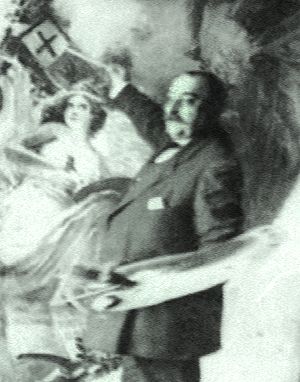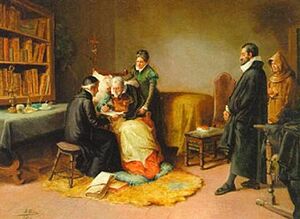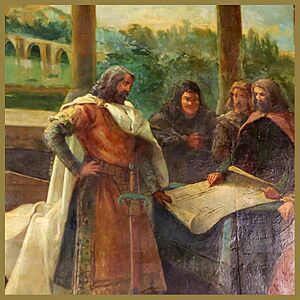Eugenio Oliva facts for kids
Quick facts for kids
Eugenio Oliva
|
|
|---|---|

Oliva at the Palencia Deputation, 1912
|
|
| Born |
Eugenio Oliva y Rodrigo
12 February 1852 Palencia, Spain
|
| Died | March 1925 Villaconejos, Spain
|
| Nationality | Spanish |
| Education | Escuela Municipal de Dibujo de Palencia; Escuela Superior de Pintura, Escultura y Grabado, Madrid |
| Known for | Painter |
| Movement | Orientalist |
Eugenio Oliva y Rodrigo (born February 12, 1852 – died March 1925) was a talented Spanish painter. He was especially famous for his large wall paintings, known as murals.
Contents
Early Life and Art Education
Eugenio Oliva was born in Palencia, a city in Spain. His father was a farmer from Murcia who also dreamed of being an artist.
Eugenio and his brother, José, both started their art journey early. They attended the "Escuela Municipal de Dibujo de Palencia," which was a local drawing school.
Around 1873, Eugenio moved to Madrid to continue his studies. He enrolled in the "Escuela Superior de Pintura, Escultura y Grabado." This school was connected to the important Real Academia de Bellas Artes de San Fernando. He also found a job in the art studios of Germán Hernández Amores, another painter from Murcia.
Studying in Rome
Eugenio did very well in his art studies. However, his first art shows in 1876 and 1878 were not as successful as he hoped.
Later in 1878, a special opportunity came up. A spot opened at the "Academia Española de Bellas Artes de Roma," an art academy in Rome. Eugenio entered a competition to win this spot and a scholarship to study there. He won!
Soon after, he married Francisco Bueno's daughter. In 1879, they both traveled to Rome.
Paintings from Rome
While in Rome, Eugenio had to send many of his artworks back to Spain. This was a requirement of his scholarship. Most of these paintings were about stories from the Bible or ancient Greek and Roman myths.
He also visited other Italian cities like Venice and Naples. There, he painted lighter, everyday scenes. After four years, he finished his studies. In 1884, he won second place at a big art exhibition in Spain for his painting of Miguel de Cervantes, a famous Spanish writer.

Important Art Projects
When Eugenio returned to Madrid, he tried to find clients for his art. Things were slow until late 1885. That's when Casto Plasencia hired him to decorate a chapel.
This chapel was in the Basílica of San Francisco el Grande. Eugenio was asked to paint murals about the Immaculate Conception.
Awards and New Commissions
In 1889, Eugenio's work in the chapel earned him the Order of Isabel the Catholic. This was a special award from the Spanish government.
This success also led to another important job. He was asked to decorate a meeting room for the Caja Madrid bank. He painted murals showing the main good qualities, known as the Cardinal Virtues.
Teaching Career
Even with these successes, Eugenio had family responsibilities. He needed a steady job, so he decided to become a teacher. In 1890, he started teaching drawing and decorative arts.
Over the next ten years, he held several temporary teaching jobs. Finally, in 1903, he became a permanent professor at the Escuela de Artes e Industrias. Later, in 1911, he got a similar permanent position at the Escuela de Artes y Oficios.

Later Works and Life
During his teaching years, Eugenio received more mural commissions. He painted murals for a private club in Valladolid called the Círculo de Recreo de la Victoria.
In 1907, his hometown of Palencia asked him to create religious murals. These were for an orphanage and a local hospital. In 1911, because of this work, he was asked to paint historical murals. These were for the lobby of the government building in Palencia. Sadly, most of these were badly damaged in a fire in 1966.
In 1919, Eugenio's son, Ángel, who was a doctor, invited his parents to live with him. They moved to Villaconejos. Eugenio spent his last years painting smaller pictures. These often showed scenes of village life and local vineyards. His wife passed away in 1924. Eugenio died in Villaconejos the following year, at the age of 73.
Images for kids
See also
 In Spanish: Eugenio Oliva para niños
In Spanish: Eugenio Oliva para niños


